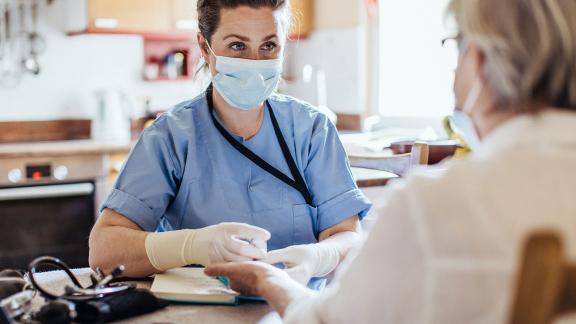Joint working between primary care and community services during COVID-19: a case study in Leeds

This case study describes the joint working between Leeds GP Federation, its constituent PCNs, and Leeds Community Health Service, which has been enabled and supported by Leeds CCG. The strong foundations of partnership working enabled a cohesive response to COVID-19 across the city and demonstrates the agility of partnerships built on trusting relationships.
Overview
This case study describes the joint working between Leeds GP Federation, its constituent PCNs, and Leeds Community Health Service, which has been enabled and supported by Leeds CCG. The strong foundations of partnership working enabled a cohesive response to COVID-19 across the city and demonstrates the agility of partnerships built on trusting relationships.
Challenges
The challenge of obtaining a consensus and consistent view from colleagues in general practice is a common one. Supported by Leeds CCG, a GP confederation was created in the city to facilitate and enable a more cohesive voice from general practice to engage in system-wide working. The CCG provided funding to support the organisation and embedded 80 staff from functions in primary care development and medicines optimisation within the confederation.
What the organisation did
The CEOs of the GP confederation and Leeds Community Healthcare NHS Trust were fully committed to working collaboratively and building stronger relationships within the community. They agreed to co-locate head office functions and to share joint appointments of some senior leaders including the medical director and director of workforce.
Both partners were involved in an annual programme of development sessions with the clinical directors of the newly formed PCNs. The sessions covered topics such as the future vision for community services, leadership models and approaches, and health inequalities. These sessions were important in building relationships between stakeholders and agreeing longer-term purpose and strategy.
The approach of working with PCNs has been to drive quality and safety improvement collaboratively and within the frameworks set by local and national contracts. Partners have consciously avoided command-and-control leadership and instead looked to build upon local knowledge and experience.
One of the challenges for PCNs has been employing staff using Agenda for Change terms and conditions. Leeds Community Healthcare NHS Trust agreed to employ staff on behalf of the PCNs and deploy them within PCNs. This has enabled the creation of a more flexible, resilient workforce with fewer employment risks for PCNs.
Both organisations worked together to improve local services, with one example being the delivery of wound services in the community. In partnership, they successfully bid for a £12 million contract to deliver the Leeds Mental Health Wellbeing Service. Both projects signalled that collaborative working could deliver improved clinical services and a better experience for all staff.
Results and outcomes
This partnership between primary and community care in Leeds has resulted in a cohesive and collective voice for general practice at system-level conversations. It has also improved the quality and safety of some community services.
- The community-based response to COVID-19 in Leeds has been cohesive thanks to the right foundations of partnership working:
- The director of adult social services co-ordinated the distribution of personal protective equipment (PPE) for the city, which included mature mutual aid for all health and care organisations.
- GP practices worked together to manage COVID-19 caseloads and support the most vulnerable patients, facilitated by the GP confederation.
- Community services worked together to support care homes and within 24 hours implemented the enhanced health in care homes service specification. Daily multidisciplinary team meetings are taking place in some care homes, which has improved communication channels between the organisations going into care homes. Similarly, sharing contact details across teams has cut out a lot of time-consuming referral processes and has led to better outcomes for residents.
- Some PCNs also created ‘safety huddles’ where primary care and community services jointly reviewed caseloads and supported the shielded patients list.
- Discharge to assess has been accelerated.
Overcoming obstacles
There have always been differences in the culture and operations of providers of NHS community services and general practice. However, the solutions are driven by neighbourhood and place-based methodologies that build genuine and meaningful dialogue across partners and reflect the local communities that they serve.
During COVID-19 the national response has been one of command and control. However, the places that have responded to the crisis most effectively have been those that had strong relationships in place prior to the pandemic. As part of the reset and recovery phase, primary and community care will continue to work together to evaluate the changes that have taken place and where there have been benefits. The joint working with PCNs and community will act as a catalyst to go further faster in Leeds. An important factor will be ensuring that resources move around the system in the right way and that contractual mechanisms do not hold back transformation.
Takeaway tips
1. Take the time to genuinely understand both partners’ perspectives and commit to building trusting relationships over the long term.
2. Build relationships across senior teams, and where appropriate look at joint appointments. Co-locate where possible and don’t underestimate the benefits of ‘corridor conversations,’ albeit some of these may now be virtual.
3. Accept that it is impossible to achieve 100 per cent consensus within the primary care community, but that managers can provide a facilitative and supportive role to create greater consensus in system-wide conversations.
4. Adopt a flexible and open mindset, working with colleagues to drive quality and safety improvements. Avoid command-and-control leadership models.
5. Celebrate successes along the way, communicating benefits to all stakeholders.
Contact details
For more information about Leeds GP Federation please contact Jim Barwick, CEO, Jim.Barwick@nhs.net or visit www.leedsgpconfederation.org.uk/
For more information about Leeds Community Healthcare NHS Trust please contact Thea Stein, CEO, TheaStein@nhs.net or visit www.leedscommunityhealthcare.nhs.uk/



